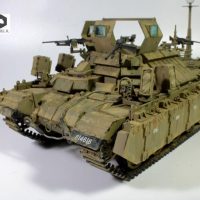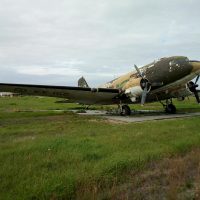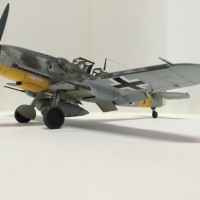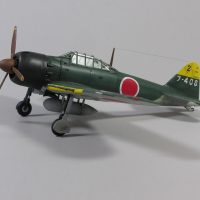What If… RAAF F-16F
This article is part of a series:
Subject
This is the third in a series of ‘what if' aircraft that I'm building.
In 1999 the Australian Department of Defence announced Project AIR 6000 "New Air Combat Capability (NACC)", which was intended to find a replacement for the air combat capability provided by both the 71 F/A-18A/B and 35 F-111C/G then in service. The F/A-18 provided air combat, strike and close air support capabilities, while the F-111 provided long range strike, reconnaissance and maritime strike capabilities to the RAAF. AIR 6000 sought to find a single platform that was able to undertake all of these missions.
Expressions of interest were sought from major aircraft manufacturers in Europe and the US and an eventual 9 contenders were under consideration. Alphabetically, these were:
-
Boeing F/A-18E/F Super Hornet
-
Boeing F-15E Strike Eagle
-
Dassault Rafale
-
Eurofighter Typhoon
-
Lockheed Martin F-16E/F Desert Falcon
-
Lockheed Martin F-22 Raptor
-
Lockheed Martin F-35 Lightning II
-
SAAB JAS-39 Gripen
-
Sukhoi Su-27/30/35 Flanker
In June 2002 Australia joined the Joint Strike Fighter (JSF) development program and announced that the Lockheed Martin F-35 would be the solution to AIR 6000, provided that the final design met the RAAF needs and budget.
In the mid 2000's I decided I would build all of these "AIR 6000" jets and this is the second one I've completed. It is my interpretation of what a RAAF Rafale might have looked like, had it been chosen instead of the F-35A.
In my personal ranking, I put the F-16F as sixth out of the nine contenders.
The original concept for the F-16 under the Advanced Day Fighter (ADF) program was as a light and manoeuvrable dogfighter with minimal electronics and no long-range missiles. The initial production versions, the F-16A (single seat) and B (dual seats), were provided with a radar capable of supporting the AIM-7 Sparrow Beyond Visual Range (BVR) missile and had a limited ground attack capability, making them more capable, but heavier, than the ADF concept.
The F-16 E and F have moved from as far from the ADF concept as it seems possible, being fitted with the AN/APG-80 Active Electronically Scanned Aperture (AESA) radar, AN/ASQ-32 Internal FLIR and Targeting System (IFTS), "Falcon Edge" Integrated Electronic Warfare System (IEWS), Link-16 Tactical Data Link (TDL), Identification Friend or Foe (IFF) transponders and Joint Helmet-Mounted Cuing System (JHMCS). [The AN/ASQ-32 is composed of the Forward Looking Infra-Red (FLIR) ball sensor above the nose and the targeting pod on the intake cheek pylon.]
The aircraft has nine weapon stations: wing tip missile rails (1 and 9) three underwing pylons each side (2-4 and 6-8), with the inner ones (4 and 6) plumbed for fuel tanks and a centre line pylon (station 5, also plumbed for fuel). It also has shoulder mounted conformal fuel tanks. Integrated weapons include AIM-9 and AIM-120 missiles, the usual array of guided bombs, AGM-152 Joint Stand-Off Weapon (JSOW) and AGM-84E Stand-off Land Attack Missiles (SLAM).
ADF aircraft are assigned a serial number starting with the prefix "A", then a type number followed by an individual aircraft number. As I rank this aircraft as sixth, I decided that it should be allocated the serial A40-006.
76 Sqn RAAF was established in 1942, the second of three P-40 squadrons formed to defend Australia and its northern approaches from the Japanese, contributing decisively to their defeat and halting their southward advance at Milne Bay. Post war it operated P-51s as part of the Allied occupation of Japan only to be disbanded in 1948. It was reformed to operate De Haviland Vampires in 1949, disbanded again in 1955, reformed to fly CAC Sabers and then Dassault Mirage IIIOs in 1960 and disbanded again in 1973. It was finally reformed in 1986 on BAE Hawk 127 jet trainers.
When the RAAF was looking to replace the Dassault Mirage IIIO in 1977, one of the contenders was the F-16A/B and, as part of their bid, General Dynamics prepared an artist's impression of an F-16A flying in Australian colours. The black and white picture shows a scheme that looks rather like the one the RAAF applied to their Mirages with a two-tone upper camouflage over a light underside. The fin has a Mirage style squadron flash with a black panther head that identifies it as being from 76 Sqn. So, I decided my F-16F should pay homage to the General Dynamics artwork.
Construction
This kit came with most of what was needed to reproduce the F-16F, except that the cockpit was rather basic and incorrect for the F-16F. So, I added a Wolfpack "F-16F Block 60 'UAE' Cockpit Set" (WP48117) which comes with accurate instrument panels and very nice ejection seats.. This was designed for the Kinetic kit, who's cockpit must be slightly shorter in length than the Hasegawa kit, because there was a small gap that needed taking care of. I set the cockpit forward and plugged the gap with a bit of plastic card. A great deal of resin had to be removed under the cockpit tub in order to get the fuselage top and bottom to close up.
The second area where this, and all Hasegawa F-16s, suffers is the lack of almost any detail in the main landing gear bay. So, I added detail based upon the best photos of this area that I could find. I used bits of sprue to make various cylinders, a reservoir tank of some sort and a red box, plus copper wire of different gauges for the various wires and pipes.
One thing the Hasegawa kit is missing is the AN/ALE-50 Towed Decoy. A friend gave me one from his Tamiya kit, which I then used to replace the station 8 pylon and mount the missile rail onto the decoy launcher. I mounted an AIM-9X from the Hasegawa Aircraft Weapons:E set on this rail and AIM-120Cs on stations 1, 2 and 9.
As the kit has minimal intake ducting, I decided to create an intake plug using some old two-part modelling clay that I had sitting around and which was nearly expired.
The rest build was as per the instructions except for the weapon loadout.
I purchased a pair of Eduard Brassin AGM-154C1 Block II JSOWs and was going to put one each on stations 3 and 7, but then I saw a photo of a Greek F-16 with a pair of JSOW mounted on station 3 using a twin BRU and decided that I would copy that. As I only had two JSOW, I mounted a GBU-31(V)3, also from the weapon set, on station 7.
The final step was the canopy. Because I couldn't work out how to prop it open with the Wolf Pack cockpit., I decided to close the canopy. As with most modern jets with blown canopies, this on had a moulding seam running down the centre that I had to sand and polish out. The final step was going to be to dip it in a new product I found, "Looks Like Glass" (thanks George, @gblair). Each time I tried I would end up with a speck of dust or bubbles ruining the finish, so I'd wipe it all off and try again. The funny thing is, each time I wiped it off the canopy looked clearer than before. That is how I left it in the end. I think the "Looks Like Glass" filed in all the micro scratches, leaving a very clear canopy.
Colours and Markings
As this is a what-if build I had no constraints on the colour scheme, although I wanted to pay homage to the General Dynamics F-16A artist's impression that inspired my choice of 76 Sqn.
I decided to do a variation on the Greek Aegean Ghost scheme but instead of two greys and a blue-grey, I kept the medium grey (Gunze Sangyo H308 Gray FS 36375) decided to replace the darker grey with a grey-green (Gunze Sangyo H61 IJN Grey).
To compliment these two colours, I wanted a greyish blue colour that was bluer than FS 35237. So, I mixed my own colour by trial and error using Intermediate Blue (Gunze Sangyo H58) and light grey (Gunze Sangyo H325 Gray FS26440). The result is perhaps a little bright, but it is growing on me.
The markings are from a number of sources, the most obvious being the 76 Sqn tail flash from the Caracal Models Mirage III Over Australia (CD48067) decal sheet which matched the one on the artist's impression.
I had some low-viz RAAF roundels that I applied in six positions, but the contrast wasn't enough to make them visible, so I removed them and created some masks using a Cricut cutter and sprayed the markings using H305 Gray FS 36118.
Conclusion.
This build was for a club “Falc-on” theme build last year for which I had it 90% complete (sans the underwing stores) and with the unsatisfactory roundels. I'm glad I've finally got her finished.
(It was only after I'd taken the photographs that I realised I've forgotten the static-discharge rods on the control surface training edges. I may add them later on.)
You can see my build log here.
















Fantastic whatiffer, Michael! Gorgeous looking F-16!
G’day Spiros (@fiveten),
Thanks, mate. It was good to finally get her done.
A great what-if Falcon, Michael @michaelt
I do like it in this tri-color scheme.
G’day John (@johnb).
Thanks, mate.
Well done, Michael (@michaelt). I love "what if" models, and this one is really cool. I like the camo, and your pieced-together decals really look like they came from a set built just for this model. I think your armament looks particularly good. You would think that if there are two kits for a specific plane, and they are both accurate, then the cockpit of one would fit the other. But we know that isn't true. Well done getting the resin to fit. I like "Looks Like Glass", but I think it is a little more delicate than Future. Wiping it off and reapplying looks really good. When I need to re-do mine, I soak it a few minutes in alcohol and it comes right off. It looks like I need to try wiping it off instead.
G’day George (@gblair),
I tried so many times to get it right by dipping it, putting it in an air-tight container, all to no avail.
I just washed it off with water each time and it still worked.
Thanks, too, for your kind comments.
Great looking build! The small red box you added to the main gear bay is actually where crew placed rolled up remove before flight flags once the pins had been removed from the landing gear on start up. I got to do this once! It was amazing doing it with the engine running right over your head!
G’day Jim (@angus64),
Wow, that wasn’t the answer I was expecting regarding the red box.
Thanks for your kind comments.
Interesting concept, Michael. Well executed. The Hasegawa F-16 is a solid model that presents all sorts of possibilities.
G’day John (@j-healy),
Thanks for looking.
True, but we are always in search of the “perfect” kit.
I recently bought the new Kinetic F-16, so I’ll see how that compares.
Wonderfully creative, Michael @michaelt! That turned out so well and really does look the part.
That turned out so well and really does look the part.  I'm excited to see what you do with the Sukhoi offering!
I'm excited to see what you do with the Sukhoi offering! 
Nice project! Very creative on the color scheme - looks good! Well done.
G’day Greg (@gkittinger),
Thanks for your kind comments, as always.
G’day Gary (@garybrantley),
Thanks for the kind comments.
I have the GWH Su-35 to build for that one
Plus, I have another “Artist’s Impression” scheme that I will copy.
Maybe I should do that next.